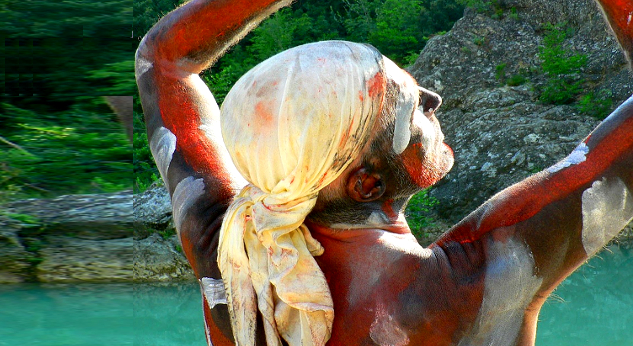
Image by Gerhard Lipold
There is no body without soul,
no body that is not itself a form of soul.
-- Sri Aurobindo
The human heart can go to the lengths of God.
Dark and cold we may be, but this
Is no winter now. The frozen misery
Of centuries breaks, cracks, begins to move,
The thunder is the thunder of the foes,
The thaw, the flood, the upstart Spring.
Thank God our time is now when wrong
Comes up to face us everywhere,
Never to leave us till we take
The longest stride of soul man ever took
Affairs are now soul size
The enterprise
Is exploration into God.
Where are you making for? It takes
So many thousand years to wake,
But will you wake for pity’s sake?
-- Christopher Fry, A Sleep of Prisoners
(in Fry, Selected Plays, 253)
Once long ago, when there was a great and terrible problem demanding resolution, a rabbi went to a certain place in the forest, lit a fire and prayed, and the problem was solved. Generations later, when another rabbi was faced with a very difficult task, he went to the same place in the forest and prayed, but he no longer could light the fire. Regardless, his wish was granted. Again, after hundreds of years, a rabbi went to the specific place in the forest because he and his people encountered a great problem. While there, he said: “We can no longer light a fire, nor do we know the secret meditations belonging to the prayer, but we do know the place in the woods to which it all belongs and that must be sufficient”; and sufficient it was.
But when another rabbi many generations later was confronted with a great and difficult task, he simply sat down and said: “We cannot light the fire, we cannot speak the prayers, we do not know the place, but we can tell the story of how it was done.” And that was sufficient, so the story goes.
The only thing that is left of the great mysteries is the “tale.” Is this sufficient?
Our current search for the mysteries, the depth of our longing, suggests that the story is not enough. Because of ego-consciousness, maybe we can’t go back to that place in the forest, light that fire, and say those prayers. How can we rediscover spirit if we don’t know where to go, how to kindle the light, or what to say?
What We Need in Order to Proceed
A recent spiritual leader in India, The Mother, speaks of the pioneering necessary to proceed: “You don’t know whether this or that experience is part of the way or not, you don’t even know if you are progressing or not, because if you knew you were progressing, it would mean that you know the way—but there is no way! No one has ever been there!”
A contemporary mystic, Satprem explains:
It was probably necessary to preach heaven to us, to draw us out of our initial evolutionary sclerosis—but this is only a first stage of evolution, which we have turned into an ultimate and rigid end. And now this end is turning against us. We have denied the Divinity in Matter, to confine it instead in our holy places, and now Matter is taking its revenge. . . As long as we tolerate this Imbalance, there is no hope for the earth. . . We need both the vigor of Matter and the fresh waters of the Spirit. . . We have lost the Password, such is the bottom line of our era. We have replaced true power with devices, and true wisdom with dogmas.
In search of the password, we gather repeatedly in our particular collectives, among our colleagues, in an effort to listen and to speak together about the evolution of our work, our efforts to better understand the evolution of our own consciousness within the different language systems of our study of human development.
In pursuit of this study, the development of each collective is a microcosm of the development of the human psyche, of the history of religions, of civilizations. We tenaciously adhere to the unfolding of the unconscious into consciousness. Satprem writes that “Becoming conscious is the very meaning of evolution,” and that “This physical life in this physical body therefore assumes special prominence among all our modes of existence, because it is here that we can become conscious— this is where the work takes place.” The Mother insists: “Salvation is physical.” Satprem explains: “The whole story of the ascent of consciousness is the story of an opening of the aperture, the passage from a linear and contradictory consciousness to a global consciousness.”
The World and Every Atom is Divine
Another story comes to mind, also from the richness of the Hasidic tradition: Once there was a great force called the universe and it became too big and much too hot. When it exploded, the trillions of moments of light fell everywhere, each becoming the source for new life . . . a salmon, a violet, a baby dove or person, a stone, an alligator. So all of us, including the tomatoes and the giraffes, have within us at our cores, a little light, a divine spark, a piece of the great light energy that is called life.
Satprem writes: “the world and every atom in the world are divine” and “the external veneer of a person usually has nothing in common with that tiny vibrating reality.” A Buddhist scholar in Tokyo, Nukariya, speaks of our source similarly: “when our inmost pure and godly wisdom . . . is fully awakened, we are able to understand that each one of us is identical in spirit, in being and in nature with universal life.”
At the very center of our differences, this light which we could call spirit or soul, radiating within each tiny newborn, reflects our sameness. The Buddhist most responsible for bringing Zen to the Western world, D. T. Suzuki, speaks of this phenomenon: “Each individual reality, besides being itself, reflects in it something of the universal, and at the same time it is itself because of other individuals.” Within a lifetime, or within generations of lifetimes, this oneness of spirit among us is usually threatened as it comes into relationship with power and economics represented by the structures of religion. Satprem tells us that the psychic being “is appropriated by churches, countless churches, which put it into articles of faith and dogma.”
How Did This Separation Happen?
Gershom Scholem writes lucidly about the history of religion. Originally, nature was the scene of the individual’s relationship to God. There was no abyss between men and women and their God. Then the “break-through” of religion occurred and created an abyss. God’s voice directed people with his laws and demands across the vast chasm. People’s voices responded in prayer, in longing, in fear, in love. The infinite distance was created. But, as Satprem explains, “Through this separation we have become conscious. We are still incompletely conscious: and we suffer, we suffer, we suffer from being separated—separated from others, separated from ourselves, separated from things and from everything because we are outside the one point where everything joins together.”
The individual is lost from a direct connection with his or her God. Scholem (1961) describes the effort then “to transform the God whom it encounters in the peculiar religious consciousness of its own social environment from an object of dogmatic knowledge into a novel and living experience and intuition” The human psyche inevitably demands to experience direct relationship with spirit, to know the sacred.
Grof calls it transpersonal, Wilber calls it the superconscious, Otto calls it the numinous, the Huichols call it Tatawari.
The Rebirth of Spirituality
The rebirth of spirituality within the New Age culture suggests the growing hunger for direct experience of god. It reflects the longing for a new container for the soul, for a new god.
The urgency of this longing is also apparent in the search, signaled by some as a lack of connectedness, an escape, confusion, and illusion. Unquestionably, the desire is to return to the old unity, but on a new plane. It has been the mystic, within religious traditions, who has lived most closely in relationship to this quest.
Copyright ©2023. All Rights Reserved.
Adapted with permission of the publisher,
Inner Traditions International.
Article Source: Intimacy in Emptiness
Intimacy in Emptiness: An Evolution of Embodied Consciousness
by Janet Adler Sharing vivid examples from founder of the Discipline of Authentic Movement Janet Adler’s 50-year inquiry, Intimacy in Emptiness brings her essential writings, including new and previously unpublished work, to a wider audience, guiding readers through the multiple layers of this experiential and innovative approach to embodied consciousness. Her writings illuminate the path of the developing inner witness, transforming toward compassionate presence, conscious speech, and intuitive knowing.
Sharing vivid examples from founder of the Discipline of Authentic Movement Janet Adler’s 50-year inquiry, Intimacy in Emptiness brings her essential writings, including new and previously unpublished work, to a wider audience, guiding readers through the multiple layers of this experiential and innovative approach to embodied consciousness. Her writings illuminate the path of the developing inner witness, transforming toward compassionate presence, conscious speech, and intuitive knowing.
Click here for more info and/or to order this hardcover book. Also available as a Kindle edition.
About the Author
 Janet Adler is the founder of the Discipline of Authentic Movement. She has been teaching and exploring emergent movement in the presence of a witness since 1969. Her archives are housed at the New York Public Library for the Performing Arts. The author of Arching Backward and Offering from the Conscious Body, she lives on Galiano Island in British Columbia, Canada. For more info, visit https://intimacyinemptiness.com/
Janet Adler is the founder of the Discipline of Authentic Movement. She has been teaching and exploring emergent movement in the presence of a witness since 1969. Her archives are housed at the New York Public Library for the Performing Arts. The author of Arching Backward and Offering from the Conscious Body, she lives on Galiano Island in British Columbia, Canada. For more info, visit https://intimacyinemptiness.com/
More Books by the author.























